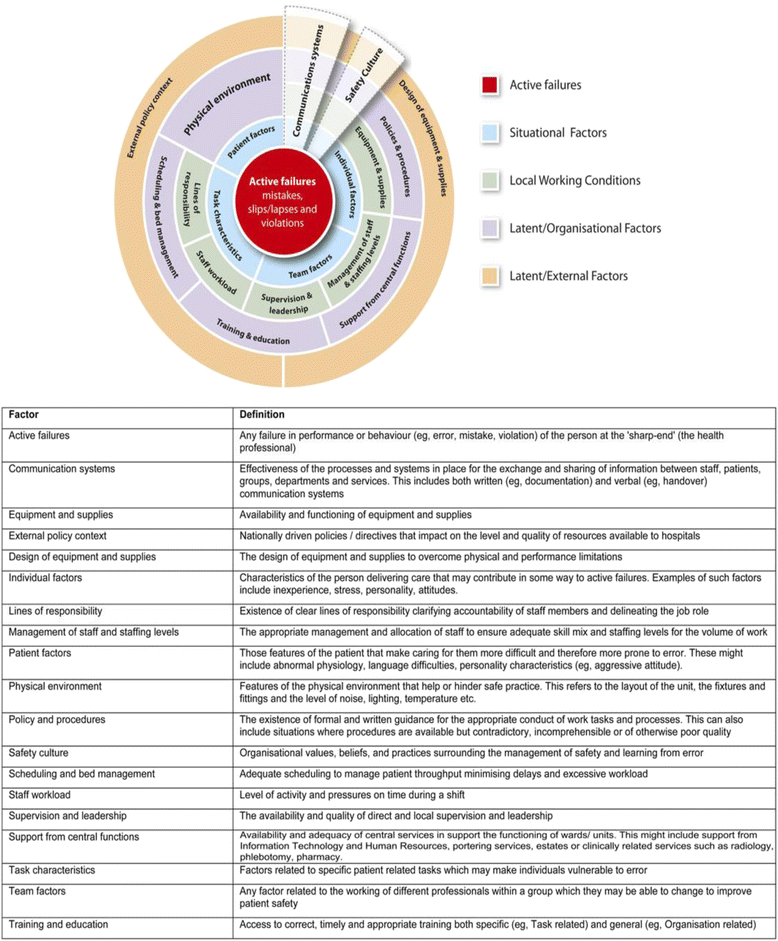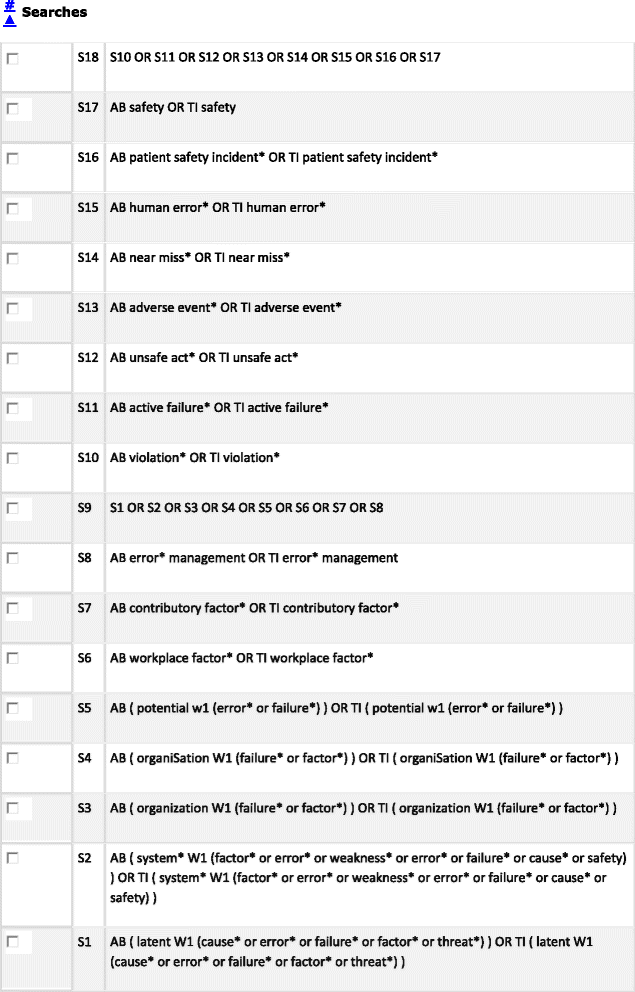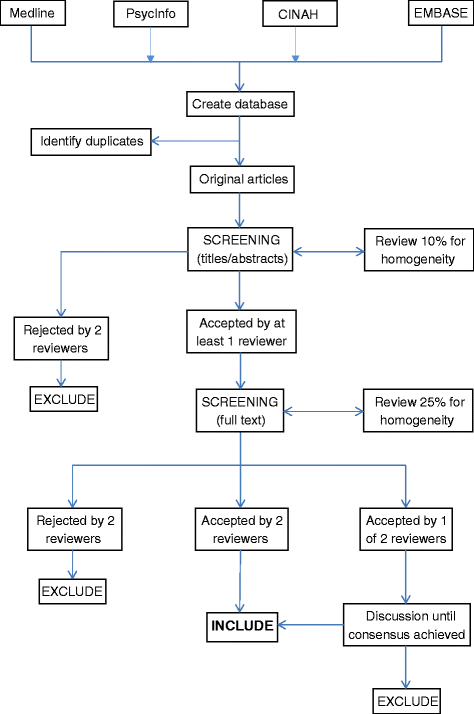Contributory factors to patient safety incidents in primary care: protocol for a systematic review
- PMID: 25947009
- PMCID: PMC4425920
- DOI: 10.1186/s13643-015-0052-0
Contributory factors to patient safety incidents in primary care: protocol for a systematic review
Abstract
Background: Organisations need to systematically identify contributory factors (or causes) which impact on patient safety in order to effectively learn from error. Investigations of error have tended to focus on taking a reactive approach to learning from error, mainly relying on incident-reporting systems. Existing frameworks which aim to identify latent causes of error rely almost exclusively on evidence from non-healthcare settings. In view of this, the Yorkshire Contributory Factors Framework (YCFF) was developed in the hospital setting. Eighty-five percent of healthcare contacts occur in primary care. As a result, this review will build on the work that produced the YCFF, by examining the empirical evidence that relates to the contributory factors of error within a primary care setting.
Methods/design: Four electronic bibliographic databases will be searched: MEDLINE, Embase, PsycInfo and CINAHL. The database search will be supplemented by additional search methodologies including citation searching and snowballing strategies which include reviewing reference lists and reviewing relevant journal table of contents, that is, BMJ Quality and Safety. Our search strategy will include search combinations of three key blocks of terms. Studies will not be excluded based on design. Included studies will be empirical studies conducted in a primary care setting. They will include some description of the factors that contribute to patient safety. One reviewer (SG) will screen all the titles and abstracts, whilst a second reviewer will screen 50% of the abstracts. Two reviewers (SG and AH) will perform study selection, quality assessment and data extraction using standard forms. Disagreements will be resolved through discussion or third party adjudication. Data to be collected include study characteristics (year, objective, research method, setting, country), participant characteristics (number, age, gender, diagnoses), patient safety incident type and characteristics, practice characteristics and study outcomes.
Discussion: The review will summarise the literature relating to contributory factors to patient safety incidents in primary care. The findings from this review will provide an evidence-based contributory factors framework for use in the primary care setting. It will increase understanding of factors that contribute to patient safety incidents and ultimately improve quality of health care.
Figures
Similar articles
-
Visual impairment and medication safety: a protocol for a scoping review.Syst Rev. 2021 Sep 15;10(1):248. doi: 10.1186/s13643-021-01800-8. Syst Rev. 2021. PMID: 34526103 Free PMC article.
-
Student and educator experiences of maternal-child simulation-based learning: a systematic review of qualitative evidence protocol.JBI Database System Rev Implement Rep. 2015 Jan;13(1):14-26. doi: 10.11124/jbisrir-2015-1694. JBI Database System Rev Implement Rep. 2015. PMID: 26447004
-
Patient and carer identified factors which contribute to safety incidents in primary care: a qualitative study.BMJ Qual Saf. 2015 Sep;24(9):583-93. doi: 10.1136/bmjqs-2015-004049. Epub 2015 May 13. BMJ Qual Saf. 2015. PMID: 25972223
-
The contribution of nurses to incident disclosure: a narrative review.Int J Nurs Stud. 2014 Feb;51(2):334-45. doi: 10.1016/j.ijnurstu.2013.07.001. Epub 2013 Jul 30. Int J Nurs Stud. 2014. PMID: 23910400 Review.
-
Factors influencing patient safety incident reporting in African healthcare organisations: a systematic integrative review.BMC Health Serv Res. 2025 Apr 30;25(1):619. doi: 10.1186/s12913-025-12762-1. BMC Health Serv Res. 2025. PMID: 40307741 Free PMC article.
Cited by
-
Developing the Resident Measure of Safety in Care Homes (RMOS): A Delphi and Think Aloud Study.Health Expect. 2023 Jun;26(3):1149-1158. doi: 10.1111/hex.13730. Epub 2023 Feb 16. Health Expect. 2023. PMID: 36797827 Free PMC article.
-
Patient safety. Factors for and perceived consequences of nursing errors by nursing staff in home care services.Nurs Open. 2021 Mar;8(2):755-765. doi: 10.1002/nop2.678. Epub 2020 Nov 13. Nurs Open. 2021. PMID: 33570279 Free PMC article. Clinical Trial.
-
Validation and initial results of surveys exploring perspectives on risks and solutions for diagnostic and medication errors in primary care in Sweden.Scand J Prim Health Care. 2020 Dec;38(4):381-390. doi: 10.1080/02813432.2020.1841531. Epub 2020 Dec 11. Scand J Prim Health Care. 2020. PMID: 33307931 Free PMC article.
-
Patient safety incidents are common in primary care: A national prospective active incident reporting survey.PLoS One. 2017 Feb 14;12(2):e0165455. doi: 10.1371/journal.pone.0165455. eCollection 2017. PLoS One. 2017. PMID: 28196076 Free PMC article. Clinical Trial.
References
-
- McEachan RC, Lawton R, O’Hara JK, Armitage GA, Giles SJ, Parveen S, et al. Developing a reliable and valid patient measure of safety in hospitals (PMOS): a validation study. BMJ Qual Saf. doi:10.1136/bmjqs-2013-002312. - PubMed
-
- Sari AB, Sheldon TA, Cracknell A, Turnbull A. Sensitivity of routine system for reporting patient safety incidents in an NHS hospital: retrospective patient case note review. BMJ. 2007;334:79. doi: 10.1136/bmj.39031.507153.AE. - DOI - PMC - PubMed
-
- VuurenW SC, van der Schaaf TW. The development of an incident analysis tool for the medical field. Eindhoven: Report from Faculty of Technology Management, University of Eindhoven; 1997.
Publication types
MeSH terms
LinkOut - more resources
Full Text Sources
Other Literature Sources
Medical
Research Materials




